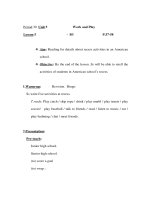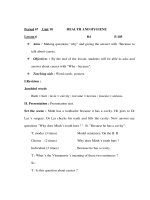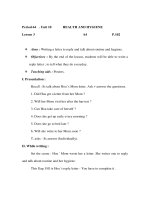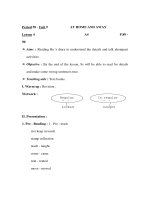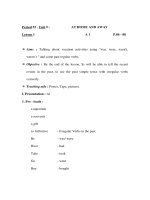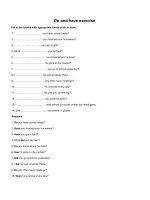Phonology and phonetics exercise p ladefoged
Bạn đang xem bản rút gọn của tài liệu. Xem và tải ngay bản đầy đủ của tài liệu tại đây (2.42 MB, 78 trang )
Name_____________________
Chapter 1, exercise A
A Fill in the names of the vocal organs numbered in Figure 1.14 below.
1. ________________________
8._____________________
2. ________________________
9._____________________
3. ________________________
10._____________________
4. ________________________
11._____________________
5. ________________________
12._____________________
6. ________________________
13._____________________
7. ________________________
14._____________________
Name_____________________
Chapter 1, exercise B
B
Describe the consonants in the word skinflint using
the chart below Fill in all five columns, and put parentheses
around the terms that may be left out, as shown for the first
consonant.
s
k
n
f
l
t
1
2
3
4
5
voiced or
place of
central or
oral or
ariculatory
voiceless
articulation
lateral
nasal
action
voiceless
alveolar
(central)
(oral)
fricative
Name_____________________
Chapter 1, exercise C
C Figure 1.15 a–g (below) illustrates all the places of articulation we have discussed so
far, except for retroflex sounds (which will be illustrated in Chapter 7). In the spaces
provided below, state (1) the place of articulation and (2) the manner of articulation of
each sound. In addition, give (3) an example of an English word beginning with the
sound illustrated.
(1) Place of articulation
a
b
c
d
e
f
g
(2) Manner of articulation
3) Example)
Name_____________________
Chapter 1, exercise D
D Studying a new subject often involves learning a large number of technical terms.
Phonetics is particularly difficult in this respect. Read over the definitions of the terms in
Chapter 1 before completing the exercises below. Say each of the words, and listen to the
sounds, Be careful not to be confused by spellings. Using a mirror may be helpful.
1.
2.
3.
4.
5.
6.
7.
8.
9.
10.
11.
12.
13.
14.
15.
16.
17.
18.
Mark the words that begin with a bilabial consonant:
met net set bet let pet
Mark the words that begin with a velar consonant:
knot got lot cot hot pot
Mark the words that begin with a labiodental consonant:
fat cat that mat chat vat
Mark the words that begin with an alveolar consonant:
zip nip lip sip tip dip
Mark the words that begin with a dental consonant:
pie guy shy thigh thy high
Mark the words that begin with a palato-alveolar consonant:
sigh shy tie thigh thy lie
Mark the words that end with a fricative:
race wreath bush bring breathe bang
rave real ray rose rough
Mark the words that end with a nasal:
rain rang dumb deaf
Mark the words that end with a stop:
pill lip lit graph crab dog hide
laugh back
Mark the words that begin with a lateral:
nut lull bar rob one
Mark the words that begin with an approximant:
we you one run
Mark the words that end with an affricate:
much back edge ooze
Mark the words in which the consonant in the middle is voiced:
tracking mother robber leisure massive stomach razor
Mark the words that contain a high vowel:
sat suit got meet mud
Mark the words that contain a low vowel:
weed wad load lad rude
Mark the words that contain a front vowel:
gate caught cat kit put
Mark the words that contain a back vowel:
maid weep coop cop good
Mark the words that contain a rounded vowel:
who me us but him
Name_____________________
Chapter 1, exercise E
E Define the consonant sounds in the middle of each of the following words as
indicated in the example:
Voiced or
Place of
Manner of
voiceless
articulation
articulation
voiced
alveolar
adder
father
singing
etching
robber
ether
pleasure
hopper
selling
sunny
lodger
stop
Name_____________________
Chapter 1, exercise F. Complete the diagrams in Figure 1.16 below so as to illustrate the
target for the gesture of the vocal organs for the first consonants in each of the following
words. If the sound is voiced, schematize the vibrating vocal folds by a wavy line at the
glottis. If it is voiceless, use a straight line.
Example:
mat
day
1
2
Name_____________________
Chapter 1, exercise G
G Figure 1.17 shows the waveform of the phrase Tom saw nine wasps. Mark this figure
in a way similar to that in figure 1.10. Using just ordinary spelling show the center of
each sound, Also indicate the manner of articulation.
0
0.5
1.0
Figure 1.17 The waveform of the phrase Tom saw nine wasps.
1.5 seconds
Name _________________
Chapter 1 Exercise H
H
Recall the pitch of the first formant (heard best in creaky voice) and the
second formant (heard best when whispering) in the vowels in the words heed,
hid, head, had, hod, hawed, hood, who’d. Compare their formants to those in the
first parts of the vowels in the following words:
First formant similar to
that in the vowel in:
Second formant similar to
that in the vowel in:
bite
________________
________________
bait
________________
________________
boat
________________
________________
Name _________________
Chapter 1 Exercise I
I
In the next chapter we will start using phonetic transcriptions.
The following exercises prepare for this by pointing up the differences
between sounds and spelling.
How many distinct sounds are there in each of the following words?
Circle the correct number.
1.
laugh
1 2 3 4 5 6 7
2.
begged
1 2 3 4 5 6 7
3
graphic
1 2 3 4 5 6 7
4.
fish
1 2 3 4 5 6
5.
fishes
1 2 3 4 5 6 7
6.
fished
1 2 3 4 5 6 7
7.
batting
1 2 3 4 5 6 7
8.
quick
1 2 3 4 5 6 7
9.
these
1 2 3 4 5 6 7
10.
physics
1 2 3 4 5 6 7
11.
knock
1 2 3 4 5 6 7
12.
axis
1 2 3 4 5 6 7
Name _________________
Chapter 1 Exercise J
J
In the following sets of words the sound of the vowel is the
same in every case but one. Circle the word that has a different vowel
sound.
1.
pen said death mess mean
2.
meat steak weak theme green
3.
sane paid eight lace mast
4.
ton toast both note toes
5.
hoot good moon grew suit
6.
dud died mine eye guy
An Introduction to Language and Linguistics
Additional Exercises – Chapter 1
1. Practice in transcription, IPA to English. Write out the following passages in
English spelling. The transcriptions represent a fairly careful “General
American” accent.
»sUd´nli D@´ »wçR´rz ´»raUnd DEm »sloli swEld In brçd
»sIrk´lz, DEn »kwIkli «√p»hivd, Qz If »said«wez »slaIRIN fr´m ´
«s√b»mIrdZd bIrg ´v aIs, »swIfli »raIzIN t´ D´ »sIrf´s. ´ lo
»r√mblIN saUnd w´z hIrd, ´ «s√btE»reni´s h√m, Qnd DEn çl
hEld Der brETs, Qz b´»drQg´ld wIT »trelIN rops, Qnd
«har»punz, Qnd »lQnsˆz, ´ vQst form Sat »lENT«waIz, b´t
«o»blikli fr´m D´ si. »SraUdˆd In ´ TIn »drupIN vel ´v mist, It
»h√v´rd for ´ »momEnt In D´ »ren«bod er, Qnd DEn fEl
»swampIN bQk »Intu D´ dip. kr√St »TIrRi fit »√pwIrdz, D´
»wçR´rz flQSt for Qn »Inst´n/ laIk hips ´v »faUnt´nz, DEn
»brok´nli sQNk In ´ »SaUw´r ´v fleks, »livIN D´ »sIrklIN »sIrf´s
krimd laIk nu mIlk raUnd D´ »marb´l tr√Nk ´v D´ wel.
o, b√t hi w√z ´ »taIt«fIstˆd hQnd Q/ D´ »grain«ston, skrudZ. ´
»skwizIN, »rEntSIN, »grQspIN, »skrepIN, »kl√tSIN, »k√v´t´s old
»sIn´r. hard Qnd Sarp Qz flIn/, fr´m wItS no stil hQd »Ev´r
str√k aut »dZEn´r´s »faI´r, »sikrIt Qnd »sElfk´n«tend, Qnd
»salI«teri Qz Qn »çIst´r. D´ kold wI»TIn hIm froz hIz old
»fitS´rz, nIpt hIz »pçIntˆd noz, »SrIv´ld hIz tSIk, »stIfInd hIz get,
med hIz aIz rEd, hIz TIn lIps blu, Qnd spok aUt »Srudli In hIz
»gretIN vçIs. ´ »frçsti raIm w√z çn hIz hEd, Qnd çn hIz
»aI«broz, Qnd hIz »waIri tSIn. hi »kQrid hIz on lo »temprItS´r
»çl«wez ´»baUt hIm, hi aIst hIz »çfIs In D´ dçg dez, Qnd »dIdˆn/
Tç I/ w√n d´»gri Q/ »krIsmIs.
»mIst´r »bINli w√z gUd »lUkIN Qnd »dZEnt´lmEn«laIk, hi hQd ´
»plEs´n/ »kaUnt´n´ns Qnd »izi «√n´»fEktˆd »mQn´rz. hIz
»sIst´rz wEr faIn »wImIm, wIT Qn er ´v d´»saIRˆd »fQS´n. hIz
»br√D´r In lç, »mIst´r hIrst, »mirli lUkt D´ »dZEnt´lm´n, b√/ hIz
frEnd »mIst´r »darsi sun dru Di ´»tEnS´n ´v D´ rum baI hIz
faIn, tçl »pIrs´n, »hQns´m »fitS´rz, »nob´l »mi´n, Qnd D´
r´»port, wItS w√z In »dZEnr´l sIrkju»leS´n wI»TIn faIv »mInIts
»Qft´r hIz »EntrEns, ´v hIz »hQvIN tEn »TaUz´nd ´ jir. D´
www.cambridge.org/fasold
© Cambridge University Press
An Introduction to Language and Linguistics
Additional Exercises – Chapter 1
»dZEnt´lmEn pro»naUnst hIm t´ bi ´ faIn »fIgj´r ´v ´ mQn, D´
»lediz d´»klerd hi w√z m√tS »hQns´m´r DQn »mIst´r »bINli,
Qnd hi w√z lUkt A/ wIT gret «QdmI»reS´n for ´»baUt hQf Di
»ivnIN.
www.cambridge.org/fasold
© Cambridge University Press
An Introduction to Language and Linguistics
Additional Exercises – Chapter 1
2. For extra practice in transcribing English to IPA, choose any passage from your
favorite book or a recent newspaper or website, and write it out in the IPA. Say
the words to yourself as you transcribe, to help ensure you’re going from sound to
transcription, not spelling to transcription. Ask another student in your class to
read what you’ve written.
3. Circle every tenth consonant in one of the passages above. Describe the
consonant in terms of voicing, nasality, place of articulation, manner of
articulation, and sonorant vs. obstruent.
4. Circle every tenth vowel in one of the passages above. Describe the vowel in
terms of height, rounding, backness, and tense vs. lax.
5. Find the transcription errors in the following well-known lines. There is at least
one mistake in each line.
twInk´l, twInk´l lIR´l star
hoU aI w√nd´r wat ju ar.
meri hQd a lIR´l lQmb
Its flis w√s waIt Qz sno
Qnd Evriwer TQt meri wEn/
D´ lQmb w√z Sur t´ go
w√n tu b√k´l my Soo
Tri for SUt D´ dor
faIv sIx pIk √p stIcks
sev´n et le DEm stret
6. Say the following groups of words:
A.
important
limp
compose
imbalance
B.
symphony
lymph
comfort
emphasis
C.
infamy
inform
confer
inference
Describe your pronunciation of the medial nasal consonant in each group. Are there
differences between the three groups? To what do you attribute any differences?
www.cambridge.org/fasold
© Cambridge University Press
An Introduction to Language and Linguistics
Additional Exercises – Chapter 1
7. Ask five different people you know to say the following line, and carefully
transcribe each person’s pronunciation. Try to include people with diverse
language backgrounds. What differences do you notice? To what would you
attribute the differences? Dialectal variation? Free variation? Influence of native
language?
Can’t you bring Laurie to the Veteran’s Day parade in the park?
8. Do you know a language other than English? If so, try to discover some of the
phonotactic constraints of that language. For example
a. Transcribe as many words as you can think of that contain sequences of nasal
+ stop. (Remember to write down sounds, not spellings!) Do the nasal and stop always
agree in place of articulation?
b. Transcribe as many words as you can think of that end with different
consonants. Are there some sounds that are not allowed in final position? Try to
formulate any relevant coda constraints with reference to natural classes of sounds.
c. Do any words begin with consonant clusters? If so, what consonant clusters
are allowed? Do the consonant clusters follow sonority sequencing?
www.cambridge.org/fasold
© Cambridge University Press
An Introduction to Language and Linguistics
Additional Exercises – Chapter 1
9. Phonemes and allophones in Korean. Consider the following Korean words (data
courtesy of Soojeong Eom, and from Martin and Lee, 1969, “Beginning Korean,”
Yale University Press). In Korean, is aspiration contrastive (as it is in Thai) or
predictable (as it is in English)? Argue for your answer.
pi
pap
pel
paN
pal
pul
rain
rice
bell
room
foot
fire
phalta
phan
phal
phi
phul
sell
board
arm
blood
grass
ton
tal
taI
tamta
tek
money
moon
bamboo
serve (on a plate)
virtue
thaIwuta
thal
thek
th o
thaI
burn
mask
chin
earth
crack
koruta
keran
kimpap
kap
kuk
kal
choose
egg
sushi
price
soup
going
khol
khata
khi
khe
khal
anger
dig up
flag
crab
knife
www.cambridge.org/fasold
© Cambridge University Press
An Introduction to Language and Linguistics
Additional Exercises – Chapter 1
10. An alternation in Korean. Consider the following words and phrases in Korean
(data courtesy of Soojeong Eom). Note that in Korean, the verb comes last, so
that “medicine sell” means “sell medicine”. Describe the alternation in the final
consonant of the nouns, making reference to natural classes. What class of
sounds is affected? What class of sounds causes a change? What is the change?
jak
jak phalta
jaN mekta
medicine
medicine sell
medicine take
chaIk
chaIk pilita
chaIN neta
book
book borrow
book put inside
pap
pap thaIwuta
pam mekta
pam neta
rice
rice burn
rice eat
rice put inside
ot
ot pilita
on mantulta
on neta
clothes
clothes borrow
clothes make
clothes put inside
How might a Korean speaker learning to speak English pronounce the phrase “pick me”?
www.cambridge.org/fasold
© Cambridge University Press
An Introduction to Language and Linguistics
Additional Exercises – Chapter 1
11. Phonemes and allophones in Setswana (Southern Africa). Consider the
distribution of [l] and [d] in the following Setswana words (data courtesy of One
Tlale). Do [l] and [d] belong to different phonemes, or are they allophones of one
phoneme?
dip-a
dup-a
dus-a
dis-a
direl-a
refuse to move
diagnose
be pregnant (animal)
herd
do something for
las-a
lep-a
lEm-a
lop-a
lap-a
lat-a
patch up
observe something
lead astray
request
get tired
follow
bol-a
bod-ile
rot
rotted
sel-a
sed-ile
find
found
bal-a
bad-ile
count
counted
robal-a
o-robed-i
sleep
he slept
In considering the present and past forms of the verbs above, compare:
tab-a
tab-ile
stab
he stabbed
bu-a
bu-ile
speak
spoke
Also consider [l] and [d] in the following borrowed words:
English:
Afrikaans:
English:
baIb´l “bible”
Setswana:
bibela
xlas “glass”
Setswana:
xalasi
p´lis “police”Setswana:
podisi
www.cambridge.org/fasold
© Cambridge University Press
An Introduction to Language and Linguistics
Additional Exercises – Chapter 1
12. For extra thought. We often think that if two sounds are allophones of one
phoneme (that is, two alternate ways of saying “the same sound”) that they ought
to be “phonetically similar.” How might the notion of phonetic similarity apply to
[l] and [d] in the Setswana problem above? What about the possible variant
pronunciations of the English phrase below?
“won’t be”
very careful speech: [wonth bi]
careful speech:
[wont/ bi]
casual speech:
[won/ bi]
www.cambridge.org/fasold
© Cambridge University Press
An Introduction to Language and Linguistics
Additional Exercises – Chapter 1
13. An alternation in Setswana (Southern Africa). Consider the following words and
phrases in Setswana (data courtesy of One Tlale). Describe the change that
occurs to the first segment of the verb when the prefix meaning “me” is added.
Describe the changes that occur in the prefix.
supa
n-tshupa
point
point at me
Sapa
¯-tShapa
hit
hit me
xapa
N-kxhapa
capture
capture me
∏ula
m-p∏hula
shoot
shoot me (actually [mphula], due to a second change)
Compare:
pha¯a
m-pha¯a
slap
slap me
tamola
n-tamola
squeeze
squeeze me
kopa
N-kopa
ask
ask me
It may be useful to know that aspiration is contrastive for both stops and affricates in
Setswana:
pala
phala
tala
tha¯a
kala
khawa
tsala
tshabana
tShaba
tSampa
unmanageable
impala
green
wake up
branch
mist
friend
afraid of each other
nation
haughty person
www.cambridge.org/fasold
© Cambridge University Press
Name_____________________
Chapter 2, exercise A
A
Find the errors in the transcription of the consonant
sounds in the following words. In each word there is one
error, indicating an impossible pronunciation of that word
for a native speaker of English of any variety. Make a
correct transcription in the space provided after the word.
1. strength
[str ”ngT]
2. crime
[
]
[craIm]
[
]
3. wishing
[wIshIN]
[
]
4. wives
[waIvs]
[
]
5. these
[Tiz]
[
]
[
]
6. hijacking [haIjœkIN]
should be
7. chipping
[tSIppIN]
[
]
8. yelling
["y”l IN]
[
]
9. sixteen
["sIxtin]
[
]
10. thesis
["DisIs]
[
]
Name_____________________
Chapter 2, exercise B
B
Now try another ten words in which the errors are
all in the vowels. Again, there is only one possible error;
but because of differences in varieties of English, there are
sometimes alternative possible corrections.
11. man-made ["manmeId] should be
[
]
12. football
["fÁt bol]
[
]
13. tea chest
["titSest]
[
]
14. tomcat
["tom kœt]
[
]
15. tiptoe
["tip toÁ]
[
]
16. avoid
[œ"vOId]
[
]
17. remain
[rE"man]
[
]
18. bedroom ["b”d rOm]
[
]
19. umbrella [um"br”lE]
[
]
["mœn œdZ]
[
]
20. manage
Name_____________________
Chapter 2, exercise C
C
Make a correct transcription of the following words. There
is still only one error per word, but it may be among the vowels,
the consonants, or the stress marks.
21. magnify
["m œgnifa I] should be
[
]
22. traffic
["t rœfIc]
[
]
23. simplistic
["sImplIstIk]
[
]
24. irrigate
["IrrIgeIt]
[
]
25. improvement
[Im "prÁvm Ent]
[
]
26. demonstrate
["dEmAnst reIt]
[
]
27. human being
[humEn "biIN]
[
]
28. appreciate
[E"preSie It]
[
]
29. joyful
["dZOyfÁl ]
[
]
30. wondrous
["wondrEs]
[
]
Name_____________________
Chapter 2, exercise D
D
Transcribe the following words or phrases as they
are pronounced by either the British or the American
speaker on the CD. Be careful to put in stress marks at the
proper places. Use a phonemic transcription, and note
which speaker you are transcribing.
Speaker_____________________
31.
languages
[
]
32.
impossibility
[
]
33.
boisterous
[
]
34.
youngster
[
]
35.
another
[
]
36.
diabolical
[
]
37.
nearly over
[
]
38.
red riding hood
[
]
39.
inexcusable
[
]
40.
chocolate pudding
[
]

